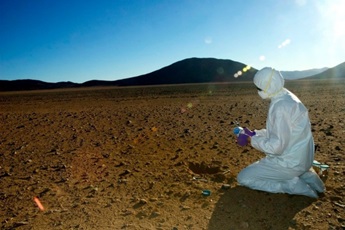Dr. Mary Beth Wilhelm
Research Scientist, NASA Ames Research Center Space Science & Astrobiology Division
Dr. Mary Beth Wilhelm is a planetary scientist and astrobiologist at NASA Ames Research Center in California. She primarily researches the preservation of molecular biosignatures in Mars analog environments on Earth and is working to design new types of instrumentation for life detection. In 2015, she was part of the team that discovered liquid water brines on Mars. Dr. Wilhelm completed her Ph.D. in Planetary Science at Georgia Tech in 2017 and her bachelor's in Earth & Planetary Science at Cornell University in 2012. She began working at NASA Ames as a high school intern in 2006 and in 2009 was the youngest Civil Servant hired in the Planetary Systems Division. Her research has taken her all over the planet, allowing her the opportunity to do field work in the Atacama Desert, Chile, and Queen Maud Land, Antarctica.
Life on Mars?

The search for life on Mars is one of the key challenges currently facing the planetary science community. The results of this search have the potential to impact our view of the nature of life. Much of the intellectual framework to address this challenge was developed for Viking Lander Missions in the 1970s and was shaped over the last few decades by NASA's Mars Exploration Program through the observations made by the numerous landers, rovers, and orbiters sent to Mars. As we begin to develop new spacecraft to search for life on Mars, we must begin with a deep understanding of Mars-like places on Earth, both to inform our search and inspire development of life-detection instrumentation. Dr. Wilhelm will discuss her research on Mars analog environments, including the driest region on Earth, the Atacama Desert, extreme Antarctic lakes, and ancient, deep salt mines. She will discuss how (or if) life survives in these extreme environments on Earth, how remnants of life get preserved in the rock record, and her recent work in development a new of life-detection instrumentation. Finally, she will discuss what it's like to be a scientist at NASA and offer advice to students aspiring to work at NASA in the future.